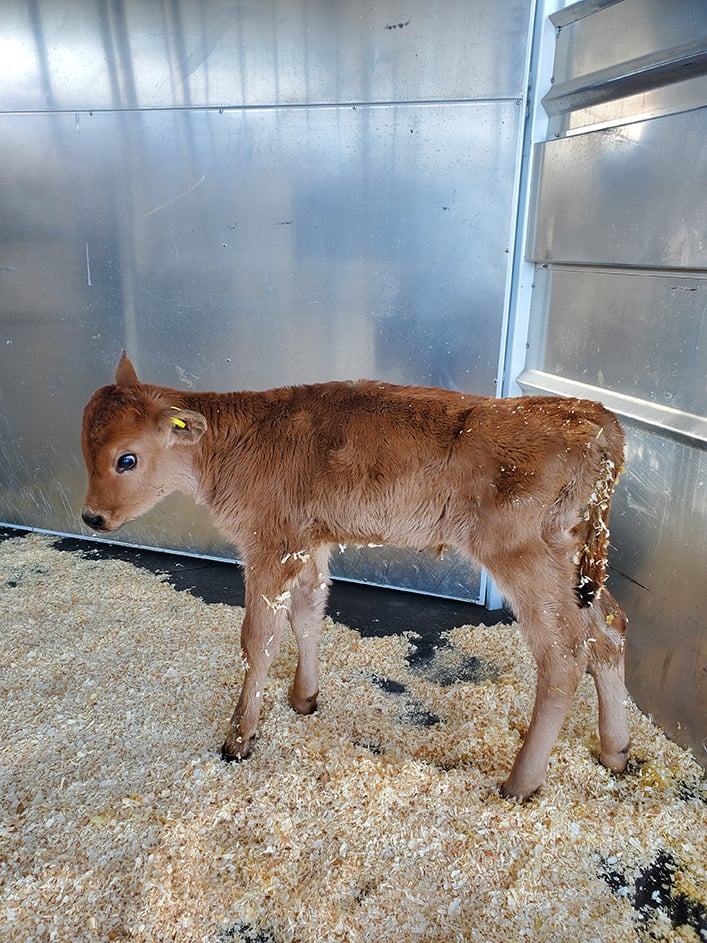Colic is a general term that describes abdominal pain. Many horse owners are familiar with the term because abdominal pain is a common condition in horses.
However, young calves can also exhibit colic symptoms and it can be caused by a variety of conditions depending on the age of the calf.
Abdominal pain in calves typically causes them to kick at their bellies.
Other symptoms may include getting up and lying down frequently, paddling of the feet and grinding of the teeth. In about 75 percent of cases of calf colic, there may also be abdominal distension caused by gas or fluid.
Read Also

Beef check-off collection system aligns across the country
A single and aligned check-off collection system based on where producers live makes the system equal said Chad Ross, Saskatchewan Cattle Association chair.
If a calf that is less than one week old displays signs of colic, the most commonly diagnosed cause is a developmental abnormality known as atresia coli.
Calves born with atresia coli have a section of their large bowel missing. As a result they are unable to defecate and will eventually die unless surgical correction is performed. These calves will often present with signs of abdominal pain and abdominal distension.
They will only have mucus and perhaps some blood in their rectum with no signs of manure production.
Atresia coli is much more common in Holstein calves but can also occur occasionally in beef calves. It is somewhat unclear if this condition is inherited.
Some researchers have speculated that very early pregnancy palpation of fetuses (which is often done in dairy cattle) may damage the vasculature of the developing colon and cause the condition.
If this is true, the use of ultrasound as a means of pregnancy diagnosis should greatly reduce the chances of this occurring.
Surgical correction is possible if the condition is diagnosed early, but it has a poor prognosis.
Other potential causes of colic in young calves might include severe cases of scours caused by bacterial or viral infections, a twisted intestine or an infection of the abdomen (peritonitis).
Older calves with colic symptoms can be the result of other conditions such as gas colic or abomasal ulcers. Gas colic is caused by abdominal distension due to gas that often occurs in the abomasum or fourth stomach or occasionally in the intestinal tract.
This condition is usually diet related and may be caused by overconsumption of milk or by gas production from certain clostridial bacteria that can proliferate in the gut.
In some cases, this gas production can result in a displaced abomasum or some other intestinal accident that may require surgical correction.
A high percentage of calves with gas colic can be treated with conservative medical therapy and some may resolve spontaneously on their own as the gas passes through their digestive tracts.
Calves with more severe conditions that result in abomasal displacement, intussusceptions or intestinal twists can often be corrected surgically if they are presented to the veterinarian before permanent damage has been done to the intestinal or abomasal wall by the gas distension.
Much of what we know about abomasal ulcers has been de-scribed by Dr. Murray Jelinski at the Western College of Veterinary Medicine.
Ninety percent of abomasal ulcers cases described in his research occurred in calves aged one to eight weeks, and then declined due to a more functional rumen.
The typical case presentation would be a fast growing, strong calf with no history of disease.
The calf would suddenly become depressed, show signs of bloat (especially in the lower abdomen), and make sloshy sounds when moving.
These calves were sometimes previously seen to be eating dirt or drinking from puddles. Most cases would die within 24 to 48 hours.
A variety of theories have been proposed to explain these cases of abomasal ulcers. Some producers report that vaccinating cows before calving and young newborns with a clostridial vaccine decreased or eliminated the problem with ulcers.
Clostridial bacteria are potentially one cause of creating an abomasal infection and might coincide with calves drinking “manure tea” from puddles or from eating dirt.
Other theories include deficiencies in trace minerals, such as copper, and hairballs in the stomach or other rough vegetation that may cause irritations that lead to ulcers.
Dr. Jelinski’s research did not confirm any of these theories, but he did show that most ulcers originate in the part of the stomach that has the poorest blood supply.
Any factor that causes the stomach of the calf to bloat and distend might therefore damage this blood supply and create an opportunity for an ulcer to form.
An overgrowth of clostridial bacteria, overconsuming milk, the presence of hairballs or other irritants all might create a situation in which the abomasum becomes distended or bloated and damages the blood supply to the stomach wall and inevitably creates an ulcer.
Colic in calves tends to be a condition that occurs sporadically in a single calf with the exception of the occasional scenario where we see an outbreak of abomasal ulcers in a herd.
A veterinarian may be able to help with medical or surgical management of some of these calves if detected early enough.

















